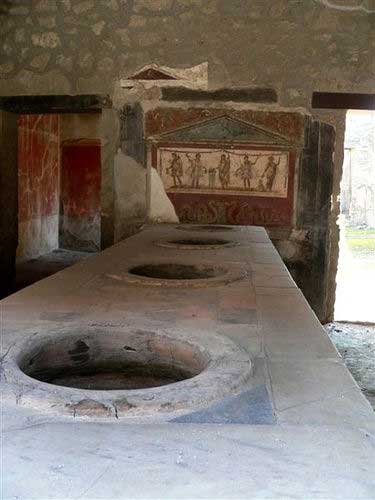McRoman’s Happy Meal: Fast Food in Ancient Rome (1st C AD)
While it’s often thought that fast food was a modern invention of a society bent on immediate gratification… well, that theory can now be placed to rest. A study on the remains found at Pompeii has revealed that, more often than not, ancient Romans ate their food while “on the run”.
Although the concept of Roman fast food eateries has been around for awhile, after excavating an entire city block from Pompeii, archaeologists realized that the distinct lack of tableware, formal dining areas, or even full kitchens in Roman homes seems to indicate that cooking – and eating together as a family – wasn’t necessarily at the forefront of ancient Roman concerns. Instead, isolated plates in various corners of the homes turned up, even in places that were previously thought to be unrelated to eating, such as in the bedroom.
This seems similar to how today’s children and adults will take a plate of food into another area of the home while working on something else, instead of always sitting down at the kitchen table to eat. In fact, many of the homes also contained mini-barbeque style implements, which would have certainly allowed someone to cook their meat faster and could eat it on the go.
In addition, there are literally remains of fast food restaurants from Pompeii. These places resemble something like a cross between McDonald’s and a British Pub, in the sense that you could purchase both food and alcohol, and could either grab it and go or sit down at little tables inside the eatery. These fast food places were open to the street, and had a large counter area with a reception area in the middle where the food and drink would be served.

Then, if you wanted, you could sit down at one of the picnic-style tables and quickly munch down your bread and hot sausage (with cheese!), or carry it off as you went about your business – or perhaps bring the food back home for the family, if the wife didn’t want to cook that evening. And while it may seem strange to think that people in ancient times could support these kinds of establishments, many of the people living in Pompeii specifically were comparatively wealthy – local artisans, shopkeepers, potters, weavers, and so on – and could therefore afford to eat out on a regular basis.
Pompeii was also a bit on the touristy side, attracting people from all over the Roman Empire, which must have helped business along as well – seemingly to the point where individuals could own more than one fast food shop, as there is a known inscription that indicates one man owned over ten “franchises” in Pompeii alone!
![A “fast food” stand where Romans could purchase breads and drinks.] A “fast food” stand where Romans could purchase breads and drinks.]](http://ancientstandard.com/images2/romanfastfood.jpg)
Based on these finds, it is extremely likely that there were also fast food shops elsewhere in the ancient Roman world, however it is doubtful that there were quite as many as there seemed to be in Pompeii. Of course, as much as the Romans liked their fast food, it should be remembered that it was undoubtedly much healthier for them to eat out on a regular basis than the choices offered to the modern consumer these days!

No comments:
Post a Comment